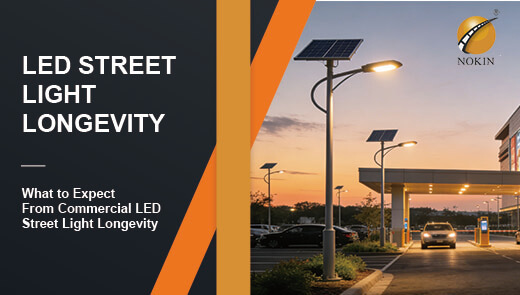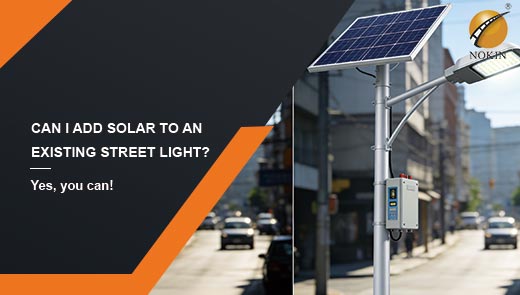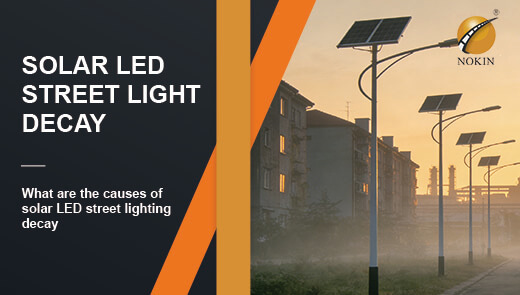A Complete Analysis of Commercial Solar Street Lights
Against the backdrop of global energy transformation, commercial solar street lights are becoming the mainstream choice in the field of public and commercial space lighting with the advantages of "zero carbon emissions and low energy consumption". According to relevant data, by 2025, the annual growth rate of the global commercial solar street light market will reach 18%, and its development trend is evident.
Compared with traditional grid street lights, commercial solar street lights directly hit the pain points of energy consumption and laying restrictions. It can not only reduce electricity bills by more than 80%, but also get rid of the constraints of cable laying, which is especially suitable for lighting needs in remote areas and emergency scenarios. This innovative lighting solution is injecting new impetus into the sustainable development of urban construction and commercial space.
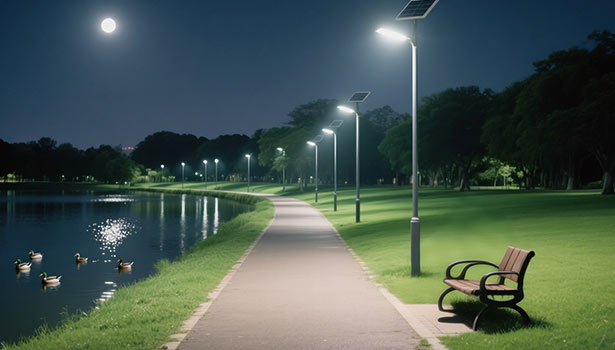
Commercial Solar Street Lights Technical Advantages
Efficient Energy Conversion System
The core of commercial solar street lights lies in their efficient energy conversion system. Solar photovoltaic panels use advanced monocrystalline silicon or polycrystalline silicon materials, and the photoelectric conversion efficiency can reach more than 20%. Under sufficient sunshine conditions, a 120W photovoltaic panel can generate about 0.5kWh of electricity per day, which is enough to meet the lighting needs of a 30W LED street light for 8 hours at night.
Reliable Energy Storage Solution
The energy storage system is the key to the stable operation of commercial solar street lights. The advanced battery types on the market currently include gel batteries and lithium batteries. Among them, gel batteries perform better in extreme temperature environments, with a capacity retention rate of more than 85% in a high temperature environment of 45℃, which is very suitable for complex outdoor climate conditions. Lithium batteries have the advantages of small size and light weight, and are suitable for scenarios with special requirements for installation space.
Intelligent Lighting Control System
Modern commercial solar street lights are equipped with advanced intelligent lighting control systems. The system usually includes modules such as light sensing control, time control function, and human body sensing. For example, light sensing control can automatically turn on or off street lights according to the intensity of ambient light; the time control function can set the switch time and dimming period of street lights; human body sensing can automatically adjust the brightness when detecting human activity, realize on-demand lighting, and maximize energy saving.
Excellent Environmental Adaptability
In order to cope with various complex climatic conditions, commercial solar street lights are designed with excellent environmental adaptability. Its protection level generally reaches IP65 or above, which can effectively resist the intrusion of rain and dust. In terms of wind resistance, the specially designed street lights can withstand strong winds of 240km/h, which fully meets the building code requirements of strong wind areas such as coastal areas.
6 Applications of Commercial Solar Street Lights
Highways and Expressways
In the lighting scenarios of highways and expressways, the lack of grid coverage in remote sections and the need for stability in bad weather are two major pain points. Commercial solar street lights show significant advantages here: its typhoon-resistant design can withstand 12-level winds, and the IP67 waterproof level ensures the stable operation of the equipment in bad weather. More importantly, 24-hour continuous lighting can be achieved without laying cables, providing a solid guarantee for road traffic safety.
Commercial Parking Lots
Commercial parking lots often face the problems of high security needs at night and high energy consumption for long-term lighting. The intelligent light sensing control function of solar street lights perfectly solves this problem - when people and cars approach, the lights automatically turn on; in energy-saving mode, the battery life can reach 8 nights, and according to statistics, the risk of theft can be reduced by more than 30%. This efficient lighting solution not only ensures the safety of the parking lot, but also realizes the rational use of energy.
Parks and Recreational Areas
Parks, playgrounds and other recreational areas have dual requirements for landscape lighting and usage time. Commercial solar street lights can be customized with warm light or white light mode according to scene requirements, and the concealed design of photovoltaic panels can improve the safety of night activities while not destroying the overall beauty of the natural landscape, achieving a harmonious unity of function and beauty.
Industrial Zone
Production operations in industrial zones usually need to be carried out continuously for 24 hours, and there are certain risks in relying on the power grid. The off-grid independent power supply characteristics of commercial solar street lights play an important role here. Commercial solar street lights can operate stably even in extreme environments of -20℃ to 60℃, providing reliable lighting support for industrial production safety.
Campuses and Educational Institutions
Campuses and educational institutions are large in area, and it is crucial to ensure the safety of teachers and students' nighttime commuting. The human body sensing and timed dimming functions of commercial solar street lights can automatically reduce the brightness to 30% in the dormitory area in the second half of the night. While taking energy saving into consideration, it can also provide clear path guidance for teachers and students, creating a safe campus night environment.
Public Squares and Trails
Public squares, outdoor shopping areas and other places have high demands for the creation of commercial atmosphere and visual consistency between day and night. Commercial solar street lights can be equipped with Cree LED lamps with a light efficiency of up to 150lm/W and a color temperature adjustable between 3000K-6500K. It can meet the aesthetic lighting needs of different scenes such as commercial pedestrian streets and cultural squares, and create a comfortable and pleasant public space environment.

How to Select the Properly Commercial Solar Street Lights?
Analysis of Lighting Requirements
When selecting commercial solar street lights, it is necessary to first conduct a detailed analysis of the lighting requirements of the application scenario. Different places have different requirements for illumination. For example, highways require an illumination of ≥20lux, while parking lots require an illumination of ≥10lux. In addition, factors such as lighting duration and light source color temperature need to be considered to ensure that street lamps can meet actual lighting needs.
Battery Capacity Calculation
Reasonable configuration of battery capacity is the key to ensuring the normal operation of commercial solar street lamps on rainy days. When calculating battery capacity, factors such as the average annual number of rainy days in the local area, the average daily power consumption of street lamps, and safety factors need to be considered. Generally speaking, the calculation formula is: average daily power consumption × number of backup days × 1.2 safety factor. For example, the average daily power consumption of a 30W street lamp is 0.24kWh. If the average annual number of rainy days in the local area is 5 days, a battery capacity of 1.44kWh (0.24×5×1.2) needs to be configured.
Control Function Selection
According to the needs of the actual application scenario, select the appropriate control function. For commercial areas with large traffic, street lamps with PIR sensing function can be selected to achieve energy-saving mode of full lighting when there are people and dimming when there are no people; for large-scale lighting projects that require unified management, intelligent control systems that support remote APP monitoring and LoRa wireless networking can be selected to facilitate real-time monitoring of the operating status of street lamps and centralized management.
Brand and Service Considerations
Although specific brands are not mentioned in this article, it is crucial to choose suppliers with good reputation and perfect service system. High-quality suppliers can provide reliable product quality assurance, such as 5-year light efficiency commitment and 10-year lamp warranty. At the same time, a perfect after-sales service system, such as 24-hour technical support and regular maintenance services, can ensure the stable operation of street lamps throughout their life cycle.
Installation and Maintenance of Commercial Solar Street Lights
Installation Process and Advantages
The installation process of commercial solar street lights is relatively simple, which has obvious advantages over traditional street lights. Since there is no need for cable trenching and complex grid connection, its installation efficiency is greatly improved. Taking a certain brand's Vertex system as an example, with the Plug-and-Play design, the installation time of a single street light can be controlled within 2 hours, and the installation efficiency is more than 4 times higher than that of traditional street lights. This simple installation method not only saves construction time, but also reduces installation costs.
Daily Maintenance Points
The maintenance cost of commercial solar street lights is low, and daily maintenance work mainly includes the following aspects:
Regularly clean photovoltaic panels and lamps: Clean the photovoltaic panels and lamps every 2-3 years or according to actual conditions, remove dust, bird droppings, dead insects and other debris on them to ensure the power generation efficiency of the photovoltaic panels and the lighting effect of the lamps.
Check the battery status: Regularly check the voltage and capacity of the battery, promptly detect and deal with battery failures, and ensure the normal operation of the battery.
Clean the surrounding vegetation: Clean the vegetation around the street lights in time to prevent the vegetation from blocking the photovoltaic panels and affecting the absorption of solar energy.
Check the equipment connection: Regularly check the connection of each component of the street light to ensure that the connection is firm to prevent equipment failure due to looseness.
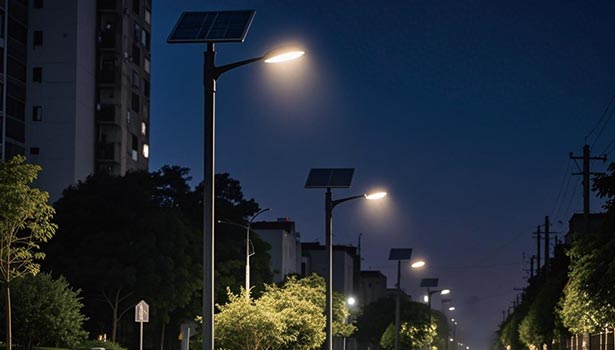
Challenges and Solutions for Commercial Solar Street Lights
What Happens If There are Cloudy Days or Many Cloudy Days in A Row?
Continuous rainy weather is one of the main challenges for commercial solar street lights. In this case, the power generation of photovoltaic panels is reduced, which may lead to insufficient battery power and affect the normal lighting of street lights. To solve this problem, the following measures can be taken:
Reasonably configure battery capacity: According to local climatic conditions, appropriately increase the number of battery backup days to cope with continuous rainy weather.
Adopt intelligent dimming strategy: In rainy weather, automatically reduce the brightness of street lights or shorten the lighting time to reduce energy consumption.
Combined with other energy supplements: In some special areas, it is possible to consider combining other renewable energy sources such as wind power to provide additional energy supplements for street lights.
How to Break Down Solar Street Light Costs?
The initial investment cost of commercial solar street lights is high, which to some extent limits its promotion and application. In order to reduce the initial investment pressure, the following solutions can be adopted:
Seek government subsidies and policy support: Actively apply for government renewable energy subsidies and tax incentives to reduce project costs.
Adopt leasing or contract energy management mode: By cooperating with professional energy service companies, adopting leasing or contract energy management mode, solar street lights can be used without large initial investment, and the cost can be paid from the saved electricity bills in the later stage.
Optimize system design: By optimizing the configuration of solar modules, batteries and lamps, the system cost can be reduced while meeting the lighting needs.
How Solar Street Lights Cope with Extreme Weather Conditions?
In some extreme environments, such as high temperature, low temperature, high humidity and other areas, the performance of commercial solar street lights may be affected. In order to ensure the stable operation of street lights in extreme environments, the following measures can be taken:
Choose suitable components and materials: For example, choose high temperature resistant VRLA gel batteries in high temperature areas, and choose low temperature resistant lithium batteries and photovoltaic panels in low temperature areas.
Optimize system heat dissipation and thermal insulation design: Through reasonable structural design, the heat dissipation and thermal insulation performance of street lights can be improved to ensure the normal operation of components under extreme temperatures.
Strengthen quality control and testing: During the product production process, strengthen quality control, conduct strict extreme environment testing on products, and ensure that the products meet the use requirements.
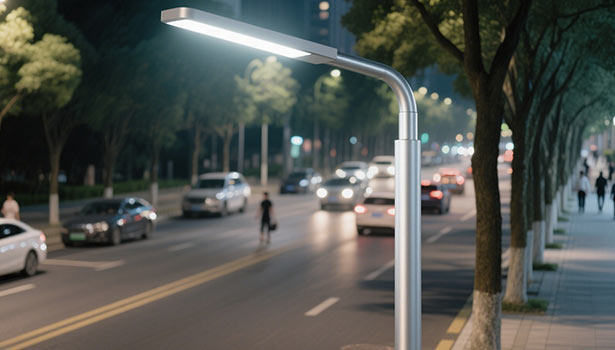
Future Trends of Commercial Solar Street Lights
Intelligence
With the continuous advancement of science and technology and the deepening of the concept of sustainable development, commercial solar street lights are developing in the direction of intelligence, modularization and efficiency. In the future, intelligent commercial solar street lights will integrate AI lighting algorithms and automatically adjust the brightness according to factors such as traffic flow and weather. It is expected that by 2026, the proportion of intelligent products in the market will exceed 60%.
Modularity
At the same time, modular design will become an important development trend of commercial solar street lights. Core components such as photovoltaic panels and batteries can be upgraded independently, which not only reduces the cost of later transformation, but also makes it easy to expand and optimize the system according to actual needs, which is very suitable for large-scale projects with long-term operation.
Efficiency
As a green, energy-saving and efficient lighting solution, commercial solar street lights are contributing important forces to urban construction and commercial development around the world. With the continuous innovation of technology and the further reduction of costs, it is believed that in the near future, commercial solar street lights will be widely used in more fields, laying a solid foundation for achieving the goal of sustainable development.

